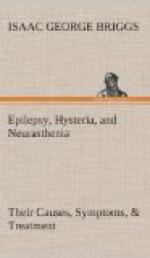Our subconscious mind does not let the past jar with the present, for life would be made bitter by the eternal vivid recollection of incidents best forgotten. Every set of ideas, as it is done with, is locked up separately in the dungeons of subconsciousness, and these imprisoned ideas form the basis of memory. Nothing is ever forgotten, though we may never again “remember” it this side the grave.
In a few cases we can unlock the cell-door and release the prisoner—we “remember”; in some, we mislay the key for awhile; in many, the wards of the lock have rusted, and we cannot open the door although we have the key—we “forget”; finally, our prisoner may pick the lock, and make us attend to him whether we wish to or not—something “strikes us”.
Normally, only one set of ideas (a complex) can hold the stage of consciousness at any one time. When two sets get on the boards together, double-consciousness occurs, but even then they cannot try to shout each other down; one set plays “leading lady”, the other set the “chorus belle” and so life is rendered bearable.
This “dissociation of consciousness” occurs in all of us. A skilled pianist plays a piece “automatically” while talking to a friend; we often read a book and think of other things at the same time: our full attention is devoted to neither action; neither is done perfectly, yet both are done sufficiently well to escape comment.
Day-dreaming is dissociation carried further. “Leading lady” and “chorus belle” change places for a while—imaginary success keeps us from worrying about real failure. Dissociation, day-dreaming, and mental epilepsy are but few of the many milestones on a road, the end of which is insanity, or complete and permanent dissociation, instead of the partial and fleeting dissociation from which we all suffer. The lunatic never “comes to”, but in a world of dreams dissociates himself forever from realities he is not mentally strong enough to face.
The writing of “spirits” through a “medium” is an example of dissociation, and though shown at its best in neuropaths, is common enough in normal men, as can be proved by anyone with a planchette and some patience.
If the experimenter puts his hands on the toy, and a friend talks to him, while another whispers questions, he may write more or less coherent answers, though all the time he goes on talking, and does not know what his hand is writing. His mind is split into two smaller minds, each ignorant of the other, each busily liberating memory-prisoners from its own block of cells in the gaol of the subconscious. The writing often refers to long-forgotten incidents, the experiment sometimes being of real use in cases of lost memory.
Dreams are dissociations in sleep, while the scenes conjured up by crystal-gazing are only waking dreams, in which the dissociation is caused by gazing at a bright surface and so tiring the brain centres, whereupon impressions of past life emerge from the subconscious, to surprise, not only the onlookers to whom they are related, but also the gazer herself, who has long “forgotten them”.




